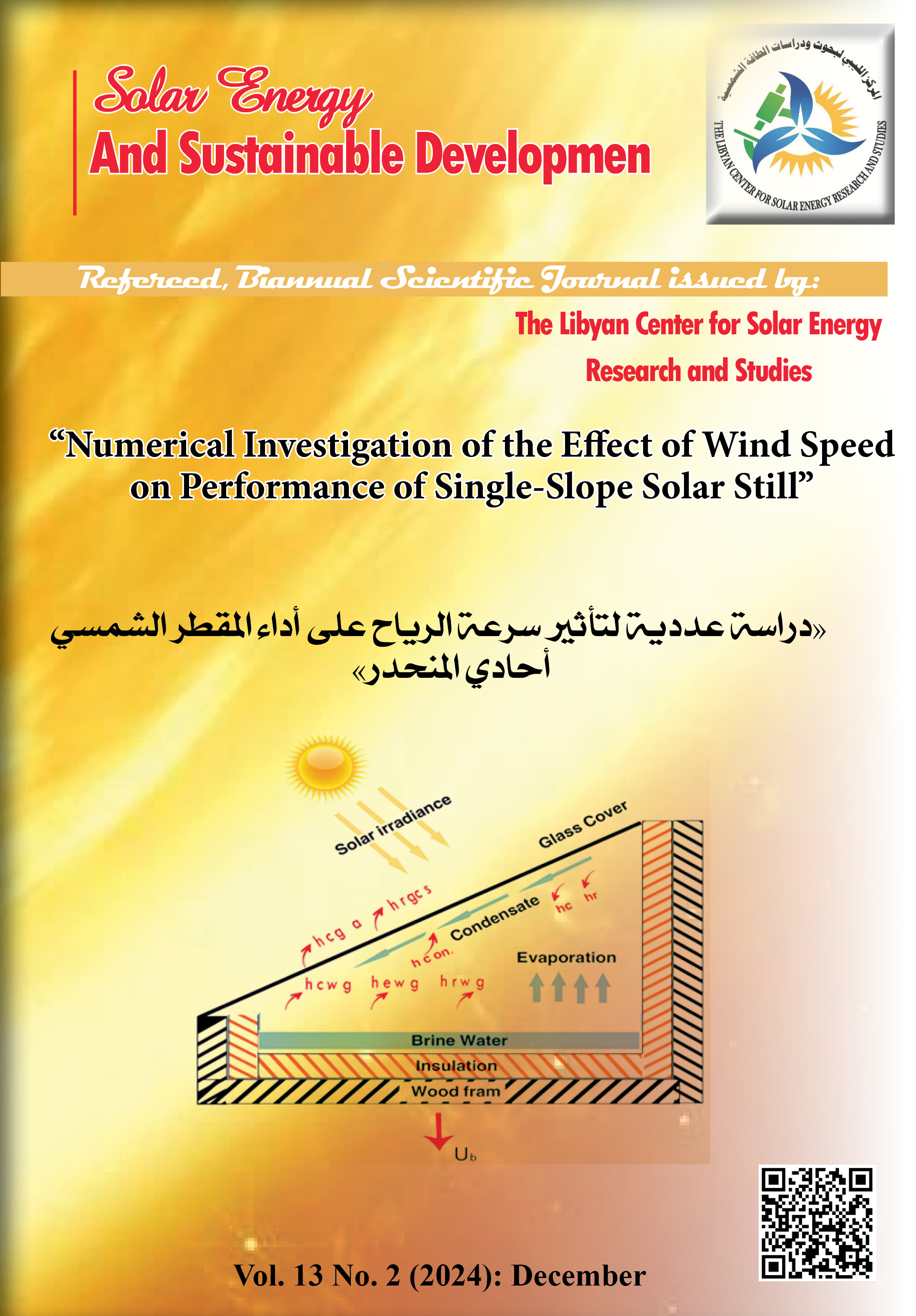Numerical Investigation of the Effect of Wind Speed on Performance of Single-Slope Solar Still
DOI:
https://doi.org/10.51646/jsesd.v13i2.241Keywords:
Single-slope solar still, performance, wind speed, vapour concentration, numerical analysis.Abstract
Pure water is an essential element for human life and other living organisms, as well as for industrial and construction processes. Many technologies have been used to produce drinking water. Most of them depend on fossil fuels as an energy source, but due to the continuous rise in fuel prices, the phenomenon of global warming, the weakness of infrastructure in many developing countries, and other factors, renewable energy has become the ideal solution to be an energy source. In this study, the effect of air velocity on the internal vapor content and its relationship with the performance of a conventional single-slope solar still was investigated numerically by Comsol Multiphsics 5.3 software. It was found that the productivity of a solar still is directly affected by the air velocity directed towards the glass cover. The forced directed air works to cool the glass cover, which leads to an increase in the temperature difference between the turbid water layer and the transparent cover layer, which enhances the condensation rates of the vapor mass at the glass cover, thus increasing the yield rate. The results showed that the total productivity of fresh water increased by about 4.7%, 10.3%, and 16% when the air velocity on the glass cover was (1.5, 3, and 4.5) m/s, respectively, compared to 0.5 m/s.
Downloads
Metrics
References
Y. Fathi et al., “Energetic Optimization of Number of Transparent Covers of Flat Plate Solar Collectors,” Wadi Alshatti University journal of Pure abs Applied Sciences, vol. 2, No.1 pp. 1–10, Mar. 2024.
M. Saeed, H. Hameed, and H. Diabil, “Experimental Investigation on Thermal Performance of Solar Air Heater using Nano-PCM,” J. Adv. Res. Fluid Mech. Therm. Sci., vol. 117, no. 1, pp. 83–97, 2024. DOI: https://doi.org/10.37934/arfmts.117.1.8397
H. Saad, B. Dikici, G. Villarroel, and E. Divo, “Characterization Methods for Biomass Materials and Optimizing Heat Transfer By Using Genetic Algorithms,” in ASTFE Digital Library, 2022. DOI: https://doi.org/10.1615/TFEC2022.emt.040794
S. Mohammed, et al., “Optimized solar food dryer with varied air heater designs,” Case Stud. Therm. Eng., vol. 53, p. 103961, 2024. DOI: https://doi.org/10.1016/j.csite.2023.103961
A. Abdullah et al., “Application of machine learning modeling in prediction of solar still performance: A comprehensive survey,” Results Eng., p. 101800, 2024. DOI: https://doi.org/10.1016/j.rineng.2024.101800
M. Saeed, D. Hachim, and H. Hameed, “Numerical Investigation forSingle Slope Solar Still Performance with Optimal Amount of Nano-PCM,” J. Adv. Res. Fluid Mech. Therm. Sci., vol. 63, no. 2, pp. 302–316, 2019.
M. Elnaggar. et al., "Design of a solar thermal powered system for electricity generation and water desalination," 2023 8th International Engineering Conference on Renewable Energy & Sustainability (ieCRES), Gaza, Palestine, 08-09 May 2023, https://doi.org/10.1109/ieCRES57315.2023.10209513 DOI: https://doi.org/10.1109/ieCRES57315.2023.10209513
L. Rtemi, W. El-Osta, A. Attaiep, "Hybrid system modeling for renewable energy sources," Journal of Solar Energy and Sustainable Development, vol. 12, no. 1, pp. 13-28. DOI: https://doi.org/10.51646/jsesd.v12i1.146
K. Lias et al., “Development of 9kWp solar system to enhance smoked shrimp (sesar unjur) production at Igan, Sarawak, Malaysia,” e-Prime - Adv. Electr. Eng. Electron. Energy, vol. 7, p. 100459, Feb. 2024. DOI: https://doi.org/10.1016/j.prime.2024.100459
A. Muftah, A. Saeid, S. El-Badri, A. Abed, and G. Smaisim, “Methods for Improving the Absorptive Capacity of Solar Stills:: A Review of Current Technology,” Sol. Energy Sustain. Dev. J., vol. 13, pp. 62–82, Jul. 2024. DOI: https://doi.org/10.51646/jsesd.v13i2.224
M. Almihat, M. Kahn, “Design and implementation of Hybrid Renewable energy (PV/Wind/Diesel/Battery) Microgrids for rural areas” Journal of Solar Energy and Sustainable Development, vol. 12, no. 1, pp. 71–95, Aug. 2023. DOI: https://doi.org/10.51646/jsesd.v12i1.151
A. Sangeetha et al., “A review on PCM and nanofluid for various productivity enhancement methods for double slope solar still: Future challenge and current water issues,” Desalination, vol. 551, p. 116367, 2023. DOI: https://doi.org/10.1016/j.desal.2022.116367
C. Kumar et al., “Solar energy: A promising renewable source for meeting energy demand in Indian agriculture applications,” Sustain. Energy Technol. Assessments, vol. 55, p. 102905, 2023. DOI: https://doi.org/10.1016/j.seta.2022.102905
H. Gad, S. El-Gayar, and H. Gad, “Performance of a solar still with clothes moving wick,” in 15th International Water Technology Conference, IWTC, 2011, pp. 28–30.
A. El-Sebaii, “Effect of wind speed on some designs of solar stills,” Energy Convers. Manag., vol. 41, no. 6, pp. 523–538, 2000. DOI: https://doi.org/10.1016/S0196-8904(99)00119-3
M. Tarawneh, “Effect of water depth on the performance evaluation of solar still,” JJMIE, vol. 1, no. 1, 2007.
H. Hameed, H. Diabil, and M. Al-Moussawi, “A numerical investigation of the enhancement of single-slope single-basin solar still productivity,” Energy Reports, vol. 9, pp. 484–500, 2023. DOI: https://doi.org/10.1016/j.egyr.2022.11.199
H. Hameed et al., “Study the effect of dust on performance of PV panel and design cleaning system,” Int. J. Energy Environ., vol. 10, no. 3, pp. 119–126, 2019.
H. Aghakhani, S. Ayatollahi, and M. R. Hajmohammadi, “A novel numerical model for solar still combined with collector and reflector,” Appl. Therm. Eng., vol. 248, p. 123123, 2024. DOI: https://doi.org/10.1016/j.applthermaleng.2024.123123
I. Al-Helal, A. Alsadon, S. Marey, A. Ibrahim, and M. Shady, “Optimizing a Single-Slope Solar Still for Fresh-Water Production in the Deserts of Arid Regions: An Experimental and Numerical Approach,” Sustainability, vol. 16, no. 2, p. 800, 2024. DOI: https://doi.org/10.3390/su16020800
A. Gupta, A. Gupta, A. Yadav, and A. Kumar, “Performance analysis of single slope solar still under composite climate in India: Numerical simulation and thermal modeling approach,” Mater. Today Proc., vol. 63, pp. 699–705, 2022. DOI: https://doi.org/10.1016/j.matpr.2022.04.956
T. Elango, A. Kannan, and K. Murugavel, “Performance study on single basin single slope solar still with different water nanofluids,” Desalination, vol. 360, pp. 45–51, 2015. DOI: https://doi.org/10.1016/j.desal.2015.01.004

Downloads
Published
How to Cite
Issue
Section
License
Copyright (c) 2024 Solar Energy and Sustainable Development Journal

This work is licensed under a Creative Commons Attribution-NonCommercial 4.0 International License.













